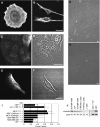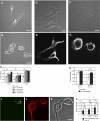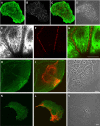Vimentin induces changes in cell shape, motility, and adhesion during the epithelial to mesenchymal transition
- PMID: 20097873
- PMCID: PMC2874471
- DOI: 10.1096/fj.09-151639
Vimentin induces changes in cell shape, motility, and adhesion during the epithelial to mesenchymal transition
Abstract
Vimentin is used widely as a marker of the epithelial to mesenchymal transitions (EMTs) that take place during embryogenesis and metastasis, yet the functional implications of the expression of this type III intermediate filament (IF) protein are poorly understood. Using form factor analysis and quantitative Western blotting of normal, metastatic, and vimentin-null cell lines, we show that the level of expression of vimentin IFs (VIFs) correlates with mesenchymal cell shape and motile behavior. The reorganization of VIFs caused by expressing a dominant-negative mutant or by silencing vimentin with shRNA (neither of which alter microtubule or microfilament assembly) causes mesenchymal cells to adopt epithelial shapes. Following the microinjection of vimentin or transfection with vimentin cDNA, epithelial cells rapidly adopt mesenchymal shapes coincident with VIF assembly. These shape transitions are accompanied by a loss of desmosomal contacts, an increase in cell motility, and a significant increase in focal adhesion dynamics. Our results demonstrate that VIFs play a predominant role in the changes in shape, adhesion, and motility that occur during the EMT.
Figures







Similar articles
-
Vimentin contributes to epithelial-mesenchymal transition cancer cell mechanics by mediating cytoskeletal organization and focal adhesion maturation.Oncotarget. 2015 Jun 30;6(18):15966-83. doi: 10.18632/oncotarget.3862. Oncotarget. 2015. PMID: 25965826 Free PMC article.
-
Expression of vimentin alters cell mechanics, cell-cell adhesion, and gene expression profiles suggesting the induction of a hybrid EMT in human mammary epithelial cells.Front Cell Dev Biol. 2022 Sep 19;10:929495. doi: 10.3389/fcell.2022.929495. eCollection 2022. Front Cell Dev Biol. 2022. PMID: 36200046 Free PMC article.
-
Impairment of Assembly of the Vimentin Intermediate Filaments Leads to Suppression of Formation and Maturation of Focal Contacts and Alteration of the Type of Cellular Protrusions.Biochemistry (Mosc). 2024 Jan;89(1):184-195. doi: 10.1134/S0006297924010127. Biochemistry (Mosc). 2024. PMID: 38467554
-
Leaving the neighborhood: molecular mechanisms involved during epithelial-mesenchymal transition.Bioessays. 2001 Oct;23(10):912-23. doi: 10.1002/bies.1132. Bioessays. 2001. PMID: 11598958 Review.
-
Induction and regulation of epithelial-mesenchymal transitions.Biochem Pharmacol. 2000 Oct 15;60(8):1091-9. doi: 10.1016/s0006-2952(00)00427-5. Biochem Pharmacol. 2000. PMID: 11007946 Review.
Cited by
-
Mathematical modeling of the impact of actin and keratin filaments on keratinocyte cell spreading.Biophys J. 2012 Nov 7;103(9):1828-38. doi: 10.1016/j.bpj.2012.09.016. Biophys J. 2012. PMID: 23199911 Free PMC article.
-
The interplay of EMT and stemness driving malignant transformation of Oral Submucous Fibrosis.J Oral Biol Craniofac Res. 2024 Jan-Feb;14(1):63-71. doi: 10.1016/j.jobcr.2023.12.006. Epub 2024 Jan 1. J Oral Biol Craniofac Res. 2024. PMID: 38261875 Free PMC article.
-
Loss of cell-cell adhesion triggers cell migration through Rac1-dependent ROS generation.Life Sci Alliance. 2022 Nov 29;6(2):e202201529. doi: 10.26508/lsa.202201529. Print 2023 Feb. Life Sci Alliance. 2022. PMID: 36446524 Free PMC article.
-
Epithelial-mesenchymal transition in tissue repair and fibrosis.Cell Tissue Res. 2016 Sep;365(3):495-506. doi: 10.1007/s00441-016-2464-0. Epub 2016 Jul 27. Cell Tissue Res. 2016. PMID: 27461257 Free PMC article. Review.
-
Increased expression of long-noncoding RNA ZFAS1 is associated with epithelial-mesenchymal transition of gastric cancer.Aging (Albany NY). 2016 Sep 18;8(9):2023-2038. doi: 10.18632/aging.101048. Aging (Albany NY). 2016. PMID: 27654478 Free PMC article.
References
-
- Hay E D. The mesenchymal cell, its role in the embryo, and the remarkable signaling mechanisms that create it. Dev Dyn. 2005;233:706–720. - PubMed
Publication types
MeSH terms
Substances
Grants and funding
LinkOut - more resources
Full Text Sources
Other Literature Sources
Miscellaneous

